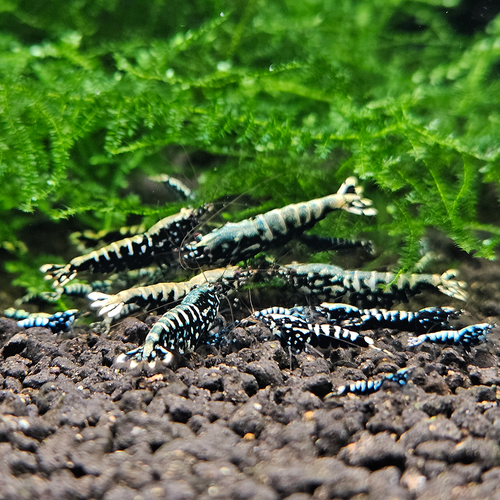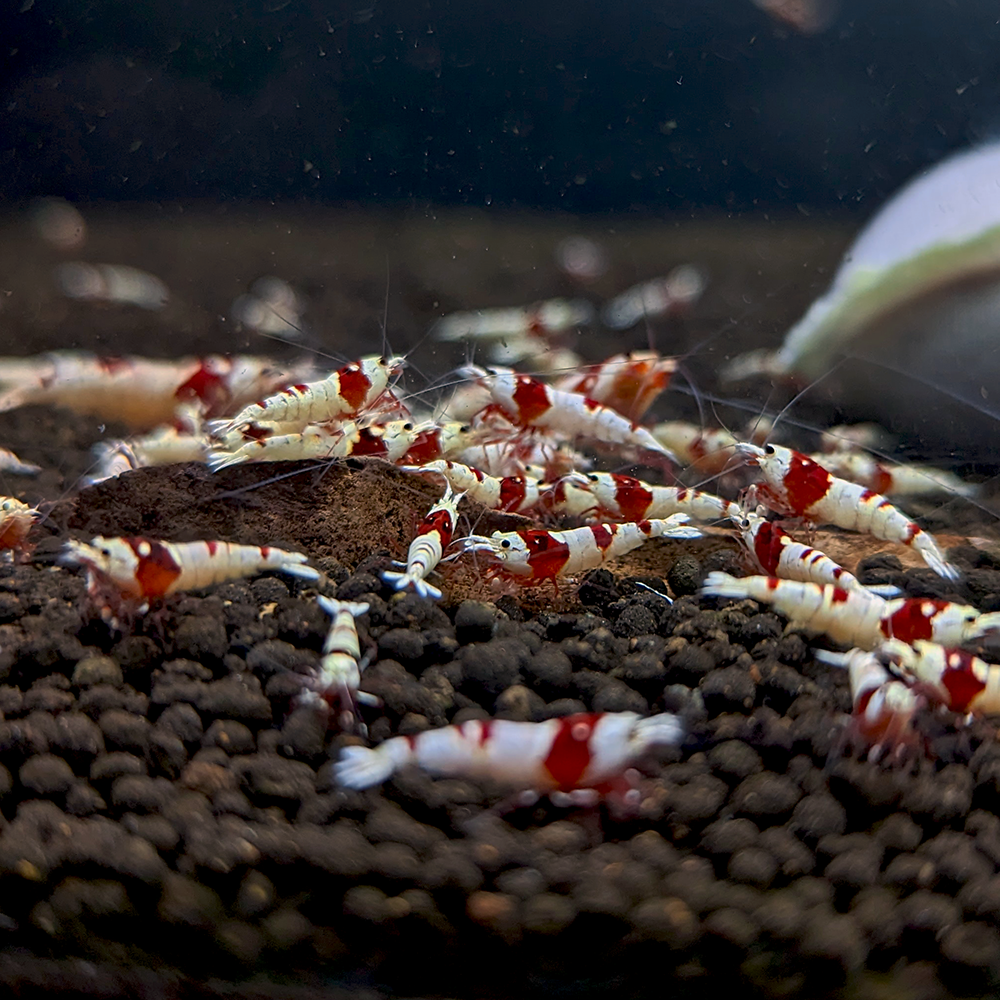So you have a caridina shrimp tank, but it's just not thriving like you want. All your basic needs are met, like having an active soil to lower the pH of your aquarium, using RODI water remineralized with a quality gh booster. Your filtration is adequate, creating decent flow through the entire aquarium. Maybe some shrimp are still dying and you don't know why, or you aren't having a very high baby survival rate. Any of these reasons can be frustrating, and maybe leave you thinking this may not be the hobby for you.
Try these tricks before throwing in the towel on your shrimp.
#1: Slow and Steady wins the race.
Taking your time, and making sure all parameters are dialed in, is key in shrimp keeping. Just like reefing, patience is a virtue; good things don't happen overnight. That is the case for your shrimp tank, too. When setting up a tank, you want to wait for your tank to mature before expecting your shrimp to thrive. That means that your parameters are balance, and your cycle is stable for the introduction of a small colony. This goes for water changes too. Don't add your water all at once, and blast them with new clean water, changing their parameters quickly. Shrimp do NOT like quick changes and will begin to die over the course of several days, leaving you scratching your head wondering what you did wrong. Any quick changes to their tank can result in devastation.
#2: Match ALL parameters before doing any water changes.
This one took me a while before I really figured it out 100%. I would do water changes, and once in a while I would end up with deaths in the next day or two and not know what was happening. Most of us know to match tds/gh before doing these water changes, but how many of us actually test the water temperature as well? I surely wasn't, and that was causing me SO MANY HEADACHES. It wasn't just deaths either, this can cause shrimp to drop eggs, or babies to hide until they starve. When we make RO water, typically that water is much colder than our room temperature tanks. While a degree or two isn't going to cause issues, and can mimic a cool rain, several degrees can stress a shrimp (potentially) to death, especially if you're like me with 50% water changes. Use that TDS meter and match water temps in your new water to your tanks.
#3: Keep your environment bioactive.
Many of us that cross into the reptile word too, know the word bioactive. This means creating an environment that sustains ALL levels of life. I find that the smallest of copepods are one of my biggest indicators of a healthy ecosystem. Without them, you can end up with a tank that doesn't process all of the waste properly. The easiest way to achieve this is with plants like moss or anubias, and a solid (light) fertilizer regimen. In this type of environment, algae and diatoms are inevitable, and these are GOOD things to have in a healthy ecosystem.
#4: Feed a healthy varied diet.
I love to feed shrimp pellets, they're easy to drop in, and fun to watch your shrimp pile up on it. But that should not be the ONLY thing you feed. Think about what your shrimp might be eating in the wild. Surely they're not getting shrimp pellets dropped into their stream. I like to add things like wood or catappa leaves to grow biofilm, one of their main sources of food. Other leaves like mulberry break down and directly feed the shrimp. I also like to add frozen foods like bloodworms or brine shrimp for some good protein once in a while (I never exceed more than once a week on the protein heavy foods). Lastly, a good dust food can be enriching for your shrimp, causing them to graze over everything like they naturally would.
#5: Avoid overcrowding.
One of the most common things I see, is people who want to start with a huge initial group. This is unnecessary, especially in smaller tanks like 10 gallons. In my breeding tanks (10 gallon) I prefer to keep my best looking male, matched up with 4-5 beautiful females. Keeping the adult shrimp population down will help create a good breeding environment. First of all, this allows the breeder shrimp to grow to their full potential (which is a lot bigger than many people realize). Fully grown females will carry more eggs to term, and you will end up with better survival rates as well. I like to have a separate grow out tank for the babies once they reach a decent size to move them, so that the breeding tank never gets overcrowded with growing babies. It's very easy to overcrowd a tank, and the first indicator is stunted growth. Very quickly after that, the breeders will just stop breeding. If this happens to you, you must reset the population. Go back to your initial breeding stock and pull as many babies that are large enough to move (typically once they're approaching the 1cm mark, I feel safe moving them) and give the tank a good water change to "reset" the parameters (and nutrients).
After taking all these tricks into consideration, and you're still having issues, there may be more to it, like quality of stock, or water quality issues. Feel free to contact me and I am more than happy to help narrow down potential issues.
Try these tricks before throwing in the towel on your shrimp.
#1: Slow and Steady wins the race.
Taking your time, and making sure all parameters are dialed in, is key in shrimp keeping. Just like reefing, patience is a virtue; good things don't happen overnight. That is the case for your shrimp tank, too. When setting up a tank, you want to wait for your tank to mature before expecting your shrimp to thrive. That means that your parameters are balance, and your cycle is stable for the introduction of a small colony. This goes for water changes too. Don't add your water all at once, and blast them with new clean water, changing their parameters quickly. Shrimp do NOT like quick changes and will begin to die over the course of several days, leaving you scratching your head wondering what you did wrong. Any quick changes to their tank can result in devastation.
#2: Match ALL parameters before doing any water changes.
This one took me a while before I really figured it out 100%. I would do water changes, and once in a while I would end up with deaths in the next day or two and not know what was happening. Most of us know to match tds/gh before doing these water changes, but how many of us actually test the water temperature as well? I surely wasn't, and that was causing me SO MANY HEADACHES. It wasn't just deaths either, this can cause shrimp to drop eggs, or babies to hide until they starve. When we make RO water, typically that water is much colder than our room temperature tanks. While a degree or two isn't going to cause issues, and can mimic a cool rain, several degrees can stress a shrimp (potentially) to death, especially if you're like me with 50% water changes. Use that TDS meter and match water temps in your new water to your tanks.
#3: Keep your environment bioactive.
Many of us that cross into the reptile word too, know the word bioactive. This means creating an environment that sustains ALL levels of life. I find that the smallest of copepods are one of my biggest indicators of a healthy ecosystem. Without them, you can end up with a tank that doesn't process all of the waste properly. The easiest way to achieve this is with plants like moss or anubias, and a solid (light) fertilizer regimen. In this type of environment, algae and diatoms are inevitable, and these are GOOD things to have in a healthy ecosystem.
#4: Feed a healthy varied diet.
I love to feed shrimp pellets, they're easy to drop in, and fun to watch your shrimp pile up on it. But that should not be the ONLY thing you feed. Think about what your shrimp might be eating in the wild. Surely they're not getting shrimp pellets dropped into their stream. I like to add things like wood or catappa leaves to grow biofilm, one of their main sources of food. Other leaves like mulberry break down and directly feed the shrimp. I also like to add frozen foods like bloodworms or brine shrimp for some good protein once in a while (I never exceed more than once a week on the protein heavy foods). Lastly, a good dust food can be enriching for your shrimp, causing them to graze over everything like they naturally would.
#5: Avoid overcrowding.
One of the most common things I see, is people who want to start with a huge initial group. This is unnecessary, especially in smaller tanks like 10 gallons. In my breeding tanks (10 gallon) I prefer to keep my best looking male, matched up with 4-5 beautiful females. Keeping the adult shrimp population down will help create a good breeding environment. First of all, this allows the breeder shrimp to grow to their full potential (which is a lot bigger than many people realize). Fully grown females will carry more eggs to term, and you will end up with better survival rates as well. I like to have a separate grow out tank for the babies once they reach a decent size to move them, so that the breeding tank never gets overcrowded with growing babies. It's very easy to overcrowd a tank, and the first indicator is stunted growth. Very quickly after that, the breeders will just stop breeding. If this happens to you, you must reset the population. Go back to your initial breeding stock and pull as many babies that are large enough to move (typically once they're approaching the 1cm mark, I feel safe moving them) and give the tank a good water change to "reset" the parameters (and nutrients).
After taking all these tricks into consideration, and you're still having issues, there may be more to it, like quality of stock, or water quality issues. Feel free to contact me and I am more than happy to help narrow down potential issues.




